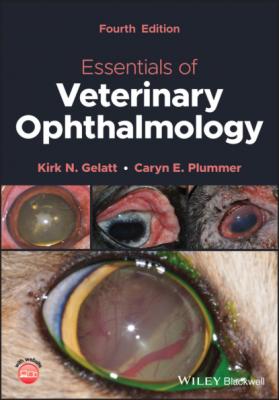Essentials of Veterinary Ophthalmology. Kirk N. Gelatt
Чтение книги онлайн.
Читать онлайн книгу Essentials of Veterinary Ophthalmology - Kirk N. Gelatt страница 34

The innermost layer is the nervous tunic, which consists of the retina and optic nerve. The three tunics embrace the large, inner, transparent media of the eye: the aqueous humor, lens, and vitreous humor, which collectively function to transmit and refract light to the retina and provide an internal pressure that keeps the globe firmly distended.
Size, Shape, and Topography
The eyes in domestic animals are quite variable in size, but their shapes are comparatively uniform, being spherical in most instances, in which the three axes of the globe (anteroposterior, horizontal or transverse, and vertical) are nearly identical in dimensions (Table 1.7). Some of the larger ungulates, including the cow and horse, possess globes that are relatively flattened in the anteroposterior axis. Two principal planes, the equatorial and meridional, are traditionally used in references to the three axes. The equatorial plane bisects the anterior and posterior poles,
and is perpendicular to the meridional plane. Any plane that runs parallel to the equatorial plane is called the frontal, coronal, radial, or transverse plane. The meridional plane moves along the anteroposterior axis of the eye, vertically dividing it into medial and lateral halves, even though meridional planes can be horizontal or oblique. Planes that run parallel to the meridional plane are described as sagittal planes.
The optic nerve in most domestic animals lies inferior and lateral to the posterior pole (Figure 1.18a and b). Surrounding the optic nerve are many ciliary nerves and short posterior ciliary arteries. In normal dogs, the mean number of short posterior ciliary arteries is 12 (~7 dorsally and ~5 ventrally). The posterior ciliary nerves pursue a long intrascleral course (up to 12 mm) at the 9‐ and 3‐o'clock positions before entering the suprachoroidal space to reach the iris, ciliary body, and limbus. In the dog, the long posterior ciliary arteries enter the sclera approximately 3–5 mm from the optic nerve in the horizontal meridian. In the cat, these arteries can enter the sclera immediately adjacent to the optic nerve. Recurrent vascular branches enter the choroid, but the main vessel trunk continues to be the major supply to the iris. A variable number of vortex veins (usually four) emerge from the sclera posterior to the equator; typically, two vortex veins are present dorsally and two ventrally.
Table 1.7 External globe dimensions (mm).
| Animal | Meridional anteroposterior axis of the eye, A (mm) | Equatorial axis, V (mm) | Horizontal, T (mm) | Ratio of A/V/T | Ratio of V/T |
|---|---|---|---|---|---|
| Horse | 43.68 | 47.63 | 48.45 | 1:1.09:1.10 | 1:1.10 |
| Cow | 35.34 | 40.82 | 41.90 | 1:1.15:1.18 | 1:1.02 |
| Sheep | 26.85 | 30.02 | 30.86 | 1:1.11:1.15 | 1:1.02 |
| Pig | 24.60 | 26.53 | 26.23 | 1:1.08:1.06 | 1:0.99 |
| Dog | 21.73 | 21.34 | 21.17 | 1:0.98:0.97 | 1:0.99 |
| Cat | 21.30 | 20.60 | 20.55 | 1:0.97:0.96 | 1:0.99 |
Cornea
The cornea is the transparent, anterior portion of the fibrous tunic of the globe. Like the lens, the cornea is normally clear, and transmits and refracts light (40–42 diopters in dogs). The avascular cornea relies on both the aqueous humor and tear film for nourishment and on the eyelids and NM for protection from the external environment. The cornea is elliptical in shape, with a horizontal diameter greater than the vertical (Table 1.8). In the dog and the cat, the difference between these diameters is small (<1–2 mm), thus making their corneas appear almost circular. In most ungulates, this difference is much more pronounced, allowing for a remarkable horizontal field of view that is further complemented by the lateral positioning of the orbits, and greater protection from predators.
Figure 1.18 (a) Lateral view of the equine globe. Note the marked flattening in the anteroposterior axis and the marked ventral exit of the optic nerve from the posterior pole. (b) Posterior view of a canine globe. LP, long posterior ciliary artery; ON, optic nerve.
Table 1.8 Width and height (mm) of the cornea measured in a straight line.
| Animal | Width | Height | Ratio of height to width |
|---|---|---|---|
| Horse | 34.0 | 26.5 | 1:1.28 |
| 33.1 | 25.8 | ||
| Cow | 30.5 | 23.2 | 1:1.29 |
| Sheep | 22.4 | 15.4 | 1:1.45 |
| Pig | 17.7 | 14.7 | 1:1.20 |
| Dog | 16.3 | 15.25 | 1:1.07 |
| Cat | 17.0 | 16.0 | 1:1.07 |
Corneal thickness varies between species, breeds, individuals, and location (i.e., central versus peripheral cornea). In most domestic animals, it is less than 1 mm thick. Corneal thickness is also influenced by age and time of day. Corneal thickness increases significantly with age in the dog, cat, and horse.
The cornea is richly supplied with sensory nerves, particularly









